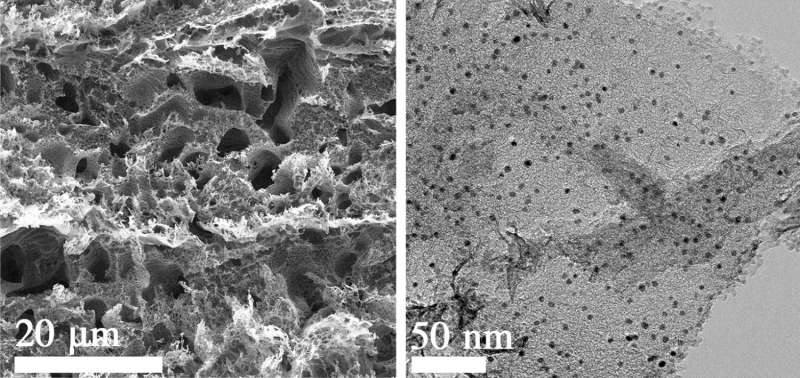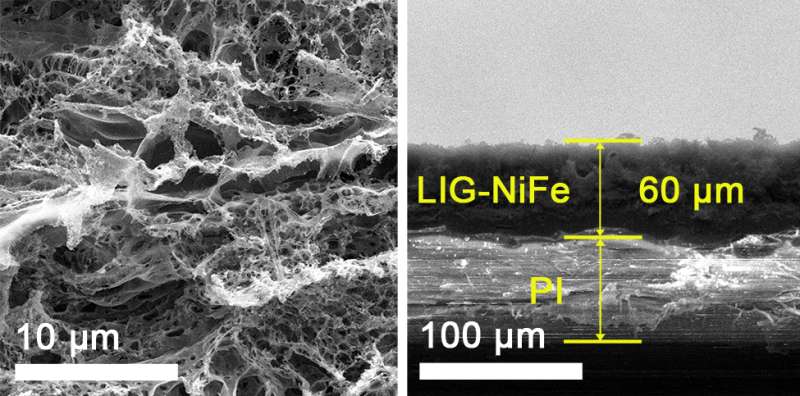Lab develops dual-surface graphene electrode to split water into hydrogen and oxygen

Rice University chemists have produced a catalyst based on laser-induced graphene that splits water into hydrogen on one side and oxygen on the other side. They said the inexpensive material may be a practical component in generating the hydrogen for use in future fuel cells.
The easily fabricated material developed by the Rice lab of chemist James Tour offers a robust and efficient way to store chemical energy. Tests showed the thin catalyst producing large bubbles of oxygen and hydrogen on either side simultaneously.
The process is the subject of a paper in the American Chemical Society's Applied Materials and Interfaces.
"Hydrogen is currently made by converting natural gas to a mixture of carbon dioxide and hydrogen gas," Tour said. "So for every two hydrogen molecules, a molecule of carbon dioxide is formed, making this traditional process a greenhouse-gas emitter.
"But if one splits water into hydrogen and oxygen, using a catalytic system and electricity generated from wind or solar energy, then the hydrogen afforded is entirely renewable," he said. "Once used in a fuel cell, it reverts back to water with no other emissions. And fuel cells are often twice as efficient as internal combustion engines, further saving energy."
The catalyst is another use for versatile laser-induced graphene (LIG), which Rice introduced in 2014. LIG is produced by treating the surface of a sheet of polyimide, an inexpensive plastic, with a laser. Rather than a flat sheet of hexagonal carbon atoms, LIG is a foam of graphene sheets with one edge attached to the underlying surface and chemically active edges exposed to the air.

LIG itself is inert, so turning it into a water splitter involves a few more steps. First, the lab impregnated the side of the plastic destined to pull hydrogen from water with platinum particles; then the lab used a laser to heat the surface and make LIG. The Rice material uses only a quarter of the platinum found in commercial catalysts, said Jibo Zhang, a Rice graduate student and lead author of the paper.
The other side, for oxygen evolution, was first turned into LIG and then enhanced with nickel and iron through electrochemical deposition. Both sides showed low onset potentials (the voltage needed to start a reaction) and strong performance over 1,000 cycles.
The lab came up with another variation: making the polyimide into an LIG catalyst with cobalt and phosphorus that could replace either the platinum or nickel-iron sides to produce hydrogen or oxygen. While the low-cost material benefits by eliminating expensive noble metals, it sacrifices some efficiency in hydrogen generation, Tour said.
When configured with cobalt-phosphorus for hydrogen evolution and nickel-iron for oxygen, the catalyst delivered a current density of 10 milliamps per square centimeter at 1.66 volts. It could be increased to 400 milliamps per square centimeter at 1.9 volts without degrading the material. The current density governs the rate of the chemical reaction.
Tour said enhanced LIG offers water-splitting performance that's comparable and often better than many current systems, with an advantage in its inherent separator between oxygen and hydrogen products. He noted it may find great value as a way to chemically store energy from remote solar or wind power plants that would otherwise be lost in transmission.
The material might also serve as the basis for efficient electrocatalysis platforms for carbon dioxide or oxygen reduction, he said.
More information: Jibo Zhang et al, Efficient Water Splitting Electrodes Based on Laser-Induced Graphene, ACS Applied Materials & Interfaces (2017). DOI: 10.1021/acsami.7b06727
Journal information: ACS Applied Materials and Interfaces
Provided by Rice University





















